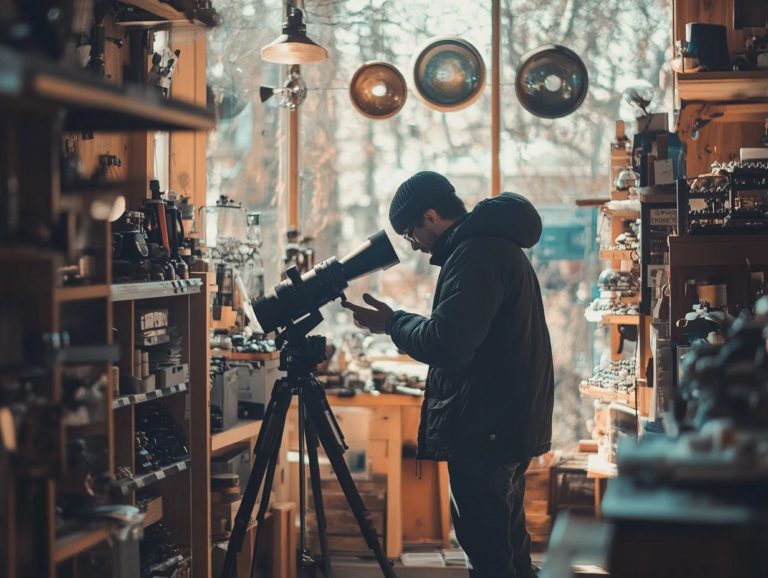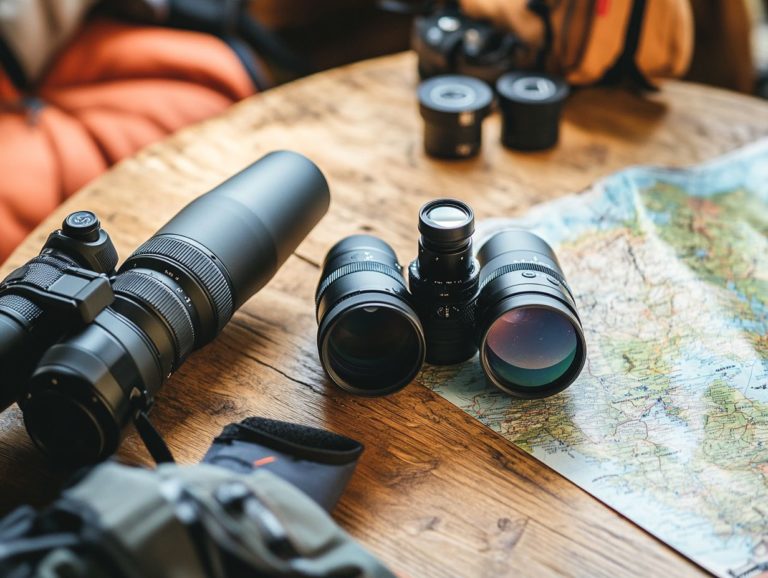Setting Up Your Spotting Scope: A Step-by-Step Guide
Are you contemplating an upgrade to your outdoor experience with a spotting scope? Whether you re a passionate birdwatcher, a dedicated wildlife enthusiast, or an aspiring stargazer, the right spotting scope can truly transform your adventures!
This guide delves into the essential factors to consider when selecting your scope, offers insights on how to set it up for peak performance, and provides tips for maintenance and effective usage.
Dive in and discover how to unlock the full potential of your spotting scope your adventures await!
Contents
- Key Takeaways:
- Choosing the Right Spotting Scope
- Setting Up Your Spotting Scope
- Tips for Using Your Spotting Scope
- Frequently Asked Questions
- 1. How do I set up my spotting scope?
- 2. Do I need any additional equipment for setting up my spotting scope?
- 3. What should I consider when choosing a location to set up my spotting scope?
- 4. How do I adjust the zoom and focus on my spotting scope?
- 5. What is the proper way to handle and store my spotting scope?
- 6. How can I keep my spotting scope in good condition?
Key Takeaways:

- When choosing your spotting scope, consider factors like magnification, objective lens size, and your budget.
- Assemble and mount your spotting scope properly by following the manufacturer’s instructions.
- Adjust focus and magnification carefully to get the best view, and maintain your scope regularly for optimal performance.
What is a Spotting Scope?
A spotting scope is an exceptional optical device meticulously crafted for detailed observation of distant subjects, making it perfect for activities like bird watching and wildlife observation amidst the great outdoors.
With an impressive magnification range typically spanning from 20x to 60x, these scopes allow you to appreciate intricate details, from feather patterns on birds to the subtle movements of animals in their natural habitats. The optical performance improves with advanced lens coatings that minimize glare and enhance light transmission, ensuring you enjoy superior image quality compared to standard binoculars.
While binoculars may appeal to you for their compact design and straightforward use, spotting scopes offer a more stable and powerful viewing experience. This makes them an invaluable tool for anyone wanting to observe nature from a distance, whether you re a seasoned birder or just beginning your journey into wildlife appreciation.
Choosing the Right Spotting Scope
Choosing the perfect spotting scope is essential for elevating your outdoor adventures, whether you re bird watching, hunting, or target shooting. The right scope will significantly impact image quality and your overall satisfaction.
As you explore your options, pay close attention to key aspects like optical performance, lens quality, and waterproof capabilities. These elements will not only enhance your wildlife observation but also elevate your photography game, ensuring that every moment in nature is captured beautifully.
Factors to Consider
When selecting the perfect spotting scope, there are several critical factors to consider to ensure optimal performance and your overall satisfaction. Start with eye relief, which is the distance from the eyepiece to your eye that affects comfort during use. Then, think about the size of the objective lens and how much closer you can see objects, as these dictate the level of detail you can capture in your observations.
Don’t overlook the quality of the optics. High-quality glass significantly enhances image clarity and minimizes distortion, which is essential when you’re out observing wildlife every detail truly matters. The construction and durability of the scope are equally important; it should be robust enough to withstand various outdoor conditions while delivering consistent performance.
Pay attention to the field of view as well. This feature directly influences your ability to track moving subjects and appreciate the beauty of the surrounding landscape. Therefore, take the time to assess these elements carefully as they will collectively shape your experience and satisfaction in both photography and wildlife observation.
Setting Up Your Spotting Scope

A proper setup of your spotting scope is crucial for attaining the finest viewing experience, whether you’re immersing yourself in nature, bird watching, or honing your skills in target shooting and other outdoor activities. For more insights, check out understanding spotting scopes.
Consider the choice between an angled model and a straight model, tailored to your specific needs, and ensure you employ a sturdy tripod setup for optimal stability during your observations, particularly for digiscoping or landscape viewing.
Now that you understand how to choose and set up your spotting scope, refer to our spotting scope buying guide and go ahead and explore the great outdoors! Share your experiences and connect with fellow enthusiasts to enhance your adventures even further.
Step 1: Assembling the Scope
Assembling your spotting scope correctly is the essential first step to achieving optimal performance and exceptional optics during your viewing sessions. For helpful advice, check out spotting scope use tips for beginners and be sure to follow the user guide meticulously. Precise assembly guarantees that every component works seamlessly together, delivering a magnified view of your chosen subject.
Neglecting these instructions can lead to frustrating misalignments that compromise focus and clarity, ultimately detracting from your overall experience. For more insights, refer to understanding spotting scope specifications. Take your time with this step for the best results! Ensure that the eyepiece, objective lens, and tripod mount are securely fastened. A quick inspection of the lenses for dirt or debris before assembly can significantly enhance image quality.
Keep in mind that the quality of optics is very important; even the finest spotting scope can falter if not assembled properly. Revisiting spotting scope etiquette tips will not only streamline your process but also help you cultivate a deeper appreciation for the art of spotting.
Step 2: Mounting the Scope
Mounting your spotting scope securely on a tripod is essential for achieving stability during your outdoor observations, ensuring that you enjoy a clear, steady image. Use a tripod adapter, which is a piece that connects your scope to the tripod, to create a robust connection between the scope and the tripod, allowing you to make quick adjustments while you focus on your subject.
A stable tripod setup not only elevates your viewing experience but also plays a pivotal role in wildlife photography. When selecting a tripod, take into account weight, height, and material, as these factors can greatly influence your ability to stabilize your equipment across various terrains.
For instance, carbon fiber tripods present a lightweight yet sturdy option, making them perfect for those long hikes. Choosing the right tripod adapter is crucial for compatibility with your scope, enhancing your versatility in the field. By balancing these elements, you’ll empower yourself to capture those fleeting moments in nature with unmatched clarity and precision.
Step 3: Adjusting the Focus and Magnification
Adjusting the focus and magnification on your spotting scope is essential for achieving that coveted visual clarity, enabling you to observe distant wildlife or landscapes in exquisite detail. For the best results, consider the top features to look for in a spotting scope. Mastering these focusing techniques will significantly elevate your viewing experience, making it easier to identify various species.
To get started, fine-tuning the focus means gently turning the adjustment knob until your subject comes into sharp relief, all while considering the lighting conditions and distance to optimize clarity.
Don t hesitate to experiment with magnification higher levels can bring birds right into your lap, but they might also limit your field of view, making it a challenge to track those swift creatures. A moderate magnification often strikes the perfect balance, allowing you to appreciate detail without losing context, making bird identification a breeze.
Stay alert to atmospheric conditions to experience the best clarity, ensuring you get the most out of your spotting scope experience.
Tips for Using Your Spotting Scope

Enhancing your user experience with a spotting scope involves grasping the best practices for both usage and maintenance, especially during outdoor pursuits like wildlife spotting or birdwatching.
By implementing these key tips, you ll not only ensure long-lasting performance of your equipment but also elevate your satisfaction during every observation, whether you re watching wildlife or bird watching.
Proper Maintenance and Care
Proper maintenance is vital for keeping your spotting scope in top shape. Regular cleaning will extend its lifespan and enhance your experience.
Inspect the lenses frequently for dust. Use a soft brush or air blower to gently remove any particles.
For thorough cleaning, use a microfiber cloth with lens cleaning solution. Waterproof scopes need special attention to prevent moisture buildup.
Store your scope in a protective case to prevent damage. This keeps it safe during all your adventures.
Best Practices for Viewing and Spotting
Using best practices can greatly enhance your bird identification skills. Know the best viewing distances and how to adjust your scope for better clarity.
Understand the habitats of different birds for easier recognition. Light conditions matter; early mornings often yield the best visibility.
Techniques like making a pishing sound can easily attract birds. Equip yourself with the right binoculars to notice fine details like plumage and beak shapes.
Frequently Asked Questions
1. How do I set up my spotting scope?

Attach your spotting scope to a sturdy tripod for stability, and refer to spotting scope maintenance for tips on keeping it in top shape. Adjust the tripod’s height and angle for your preferred viewing position.
Next, attach the eyepiece and focus until the image is clear. Use the zoom and focus knobs to refine your view.
2. Do I need any additional equipment for setting up my spotting scope?
You’ll need a tripod and an eyepiece, but don’t forget a mounting adapter if your spotting scope doesn’t include one. For more insights on selecting the right equipment, consider spotting scope selection, as this will help you attach the scope securely to the tripod.
A carrying case or protective cover is also a smart choice to keep your scope safe during transport. Consider investing in waterproof optics for outdoor adventures to ensure durability in all weather conditions.
3. What should I consider when choosing a location to set up my spotting scope?
Choose a spot with a clear view of your subject. Stay away from trees, buildings, and other tall objects that could block your vision.
Make sure to set up on a stable and level surface for your tripod. This will help you capture steady and clear images.
4. How do I adjust the zoom and focus on my spotting scope?
Most spotting scopes have two knobs or rings for zoom and focus adjustments. The zoom knob is usually on top and lets you change how close you see your subject.
The focus knob is found near the eyepiece and sharpens the image for better clarity. It’s simple to use once you get the hang of it!
5. What is the proper way to handle and store my spotting scope?
Always hold your spotting scope by the barrel and avoid touching the lenses. Protect it from extreme temperatures, moisture, and direct sunlight.
Store your scope in a cool, dry place with the lens caps on to keep out dust and dirt. Protect your investment by using a tripod adapter for extra stability outdoors!
6. How can I keep my spotting scope in good condition?
Keep your spotting scope in top shape! Regular cleaning and proper storage are key.
Use a lens brush or compressed air to clear debris from the lenses. Wipe away smudges with a microfiber cloth.
Consider having a professional service your scope every few years. This ensures it stays in great working order.
With regular maintenance, you’ll enjoy clear views and get the most out of your investment!






